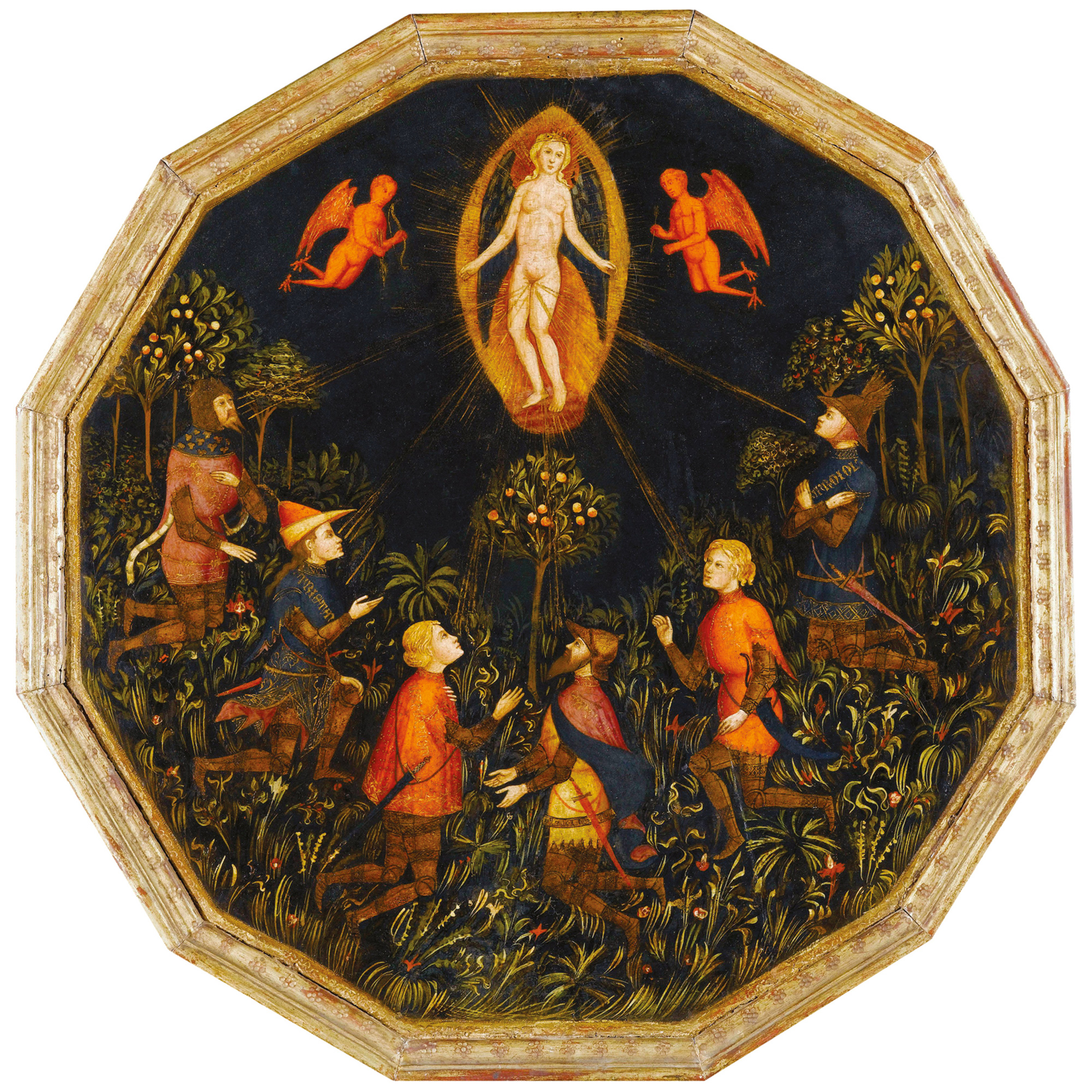Platter of Love
Fruit of the womb
D. Graham Burnett and Yael Geller
It is a twelve-sided painted wooden board about two feet in diameter, currently residing in the collections of the Louvre. Known in Italian as a desco da parto, or “birth tray,” such ornate serving platters were a standard-issue household item among the grand families of Tuscany in the quattrocento. Wealthy houses prepared them to celebrate the birth of an heir, and they functioned to bear sweetmeats, fruit, and other refreshments to the bedbound mother who had just delivered herself of a living child. This one is remarkable.
• • •

In the precise and jewel-hued image, six men kneel attentively amidst the stylized flowers and trees of a pleasant garden. Above them, hovering in the air, surrounded by a radiant mandorla (the almond-shaped body halo generally reserved for medieval saints), hangs a winged female figure, open-armed and shedding rays of light. A pair of angel-like creatures floats to her left and right. The men’s devotional gazes—chaste, placid, devout—all fix upward on this glowing apparition, and several of the figures raise hands in supplication, one holding his arms crossed before his chest in a posture of prayerful respect. At a glance—say, fighting your way through the hoards of tourists looking for the Mona Lisa—you’d likely make a mental note along the following lines: “Hmm, some saint or whatnot, bunch of chivalrous worshippers; same old, same old.”
• • •
You’d be importantly wrong, however. And a closer look would tip you off. For starters, those little angelic attendants have claws for feet—definitely non-standard for polite putti. Plus, the glowing blond female figure with wings is actually stark naked, which at least suggests that she’s probably not the Madonna. But the real kicker—the real “what the hell is going on here?” detail—lies in those needle-fine rays of golden luminance, which stream down on the supplicants from the object of their worship. Each of these gilt zips originates from a single point on the body of this beatific floating female—the exact convergence of her small pubic wedge. A line of divine radiance runs from this celestial crotch directly into the upturned eyes of every member of this chorus of male admirers. So we are emphatically not talking about any regular Christian saint, or any ordinary convocation of the faithful.
• • •
She is, of course, Venus, the goddess of love. And her circle of worshippers consists of figures drawn from the greatest legends of consuming desire: they are Achilles, Tristan, Lancelot, Samson, Paris, and Troilus. Like any learned Renaissance work, the painting is a dense confection of classical myth, vernacular literature, and Christian tradition: yes, she is Venus, but those wee devils do not hail from Venus’s pagan Rome; they are, of course, borrowed from the stern teachings of those clerical moralists in the service of the pope. Samson, in turn, is visiting from Hebrew scripture, but here he shares the stage with a womanizing knight of the round table, a famously tragic Latin lover, a Greek demigod with a penchant for boy-men, the abductor-provocateur who started the Trojan war, and the doomed hero of a popular French romance. And the whole scene—we are in a garden, recall, with some trees bearing very tempting fruit—is obviously meant to invoke that notorious Edenic park of old where a certain naked woman proved such a problematic temptress. So our hovering apparition of female erotic omnipotence is mostly Venus, but there’s definitely a little Eve in there too. Beneath her feet, a fruited tree.
• • •